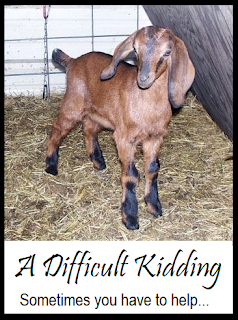
For many years I'd feared that one of my goats would have a difficult birth.
And of course, it was inevitable that it would eventually happen. While most goat kiddings are completely normal, once in a while there is a problem.
So it was that I found Dream in labor one early afternoon. I kept a watch on her, and eventually I saw.... um.... ears. Not a nose, not a front hoof, but two ears laid together like the numeral "11". Oh, this was not good.
I felt around with a finger and thought that the kid's nose was pointing up towards the doe's spine, with the back of the head pressing down against the doe's cervix. I knew that the kid would not come out in this position.
I prayed. I remembered a sheep-owning friend who had to have her husband hold a ewe up with her nose to the ground so the lamb would fall back inside a bit and my friend could reposition it.
This kid's head was right up against the pelvic bone and I couldn't find the nose with my finger. I was pretty sure this is what I was going to have to do too, so there would be a bit of room to hopefully fix the situation.
I called another goat-owning friend and she told me the same thing: tip the doe's hindquarters up in the air, push the kid back in, and find the nose. Finding a hoof would be even better, and pull it forward. If necessary, grab the jaw and pull the kid out.
I was on my own
Back in those early days at Oak Hill, no local veterinarian would work on goats; the closest caprine vet was nearly two hours away. I was on my own.
So I convinced Hubby that he had no choice but to come outside and help me. I promised he wouldn't get "icky." He lifted up the doe's hind end and the kid fell back inside just enough that I could get my hand in while she was still in the air and find the nose.
That little nose was actually underneath, not pointing upwards as I'd originally thought. I felt the nostrils and then my fingers slid across an eye.
I found the jaw and straightened out the head, and as the doe contracted again I guided the nose out. Dream rested for a short time before she tried again. I pulled downward on the kid as she pushed, and the kid crashed onto the ground. A big buckling, dead.
As Dream licked off the kid and talked to him (poor thing, I thought, I'm going to hate taking the dead baby away from her), I called my friend back and reported the outcome. As we talked, another baby was born.
I hadn't expected twins as Dream wasn't very wide this year, and the buckling was big, but in just a few minutes this small live doeling was born. We had a happy ending after all!
Sometimes you have to help
Most goats will kid without problems, but sometimes they need help. Fortunately more veterinarians are willing to work on goats nowadays. I recommend that you find one of these priceless resources before your goats are due to kid, just in case.
Don't be afraid to call your veterinarian if you need help, no matter what time of day or night.
If you can't get hold of a veterinarian or someone else who can help, the helpful folks in this Facebook group Goat Emergency Team will try to help talk you through a difficult situation. Always try to contact a vet first, hands-on help is best!
NOTE: You should join this group before you need help. Be sure to check the group rules.
As a goat lover and a homestead gardener, I'm excited to also share my gardening tips with you - from planting seeds to enjoying the fruits (and vegetables) of your labor! You can find my gardening advice and insights right here, so let's dig in and cultivate some fresh, delicious produce together.
For more simple living and homesteading ideas and inspiration, subscribe to The Acorn, Oak Hill's weekly-ish newsletter, and join me on Facebook, Instagram and Pinterest. I'd love to see you there!
Related Post:
How to Know Your Goat is in Labor including a video of a goat birth.
This post first appeared on oakhillhomestead.com














